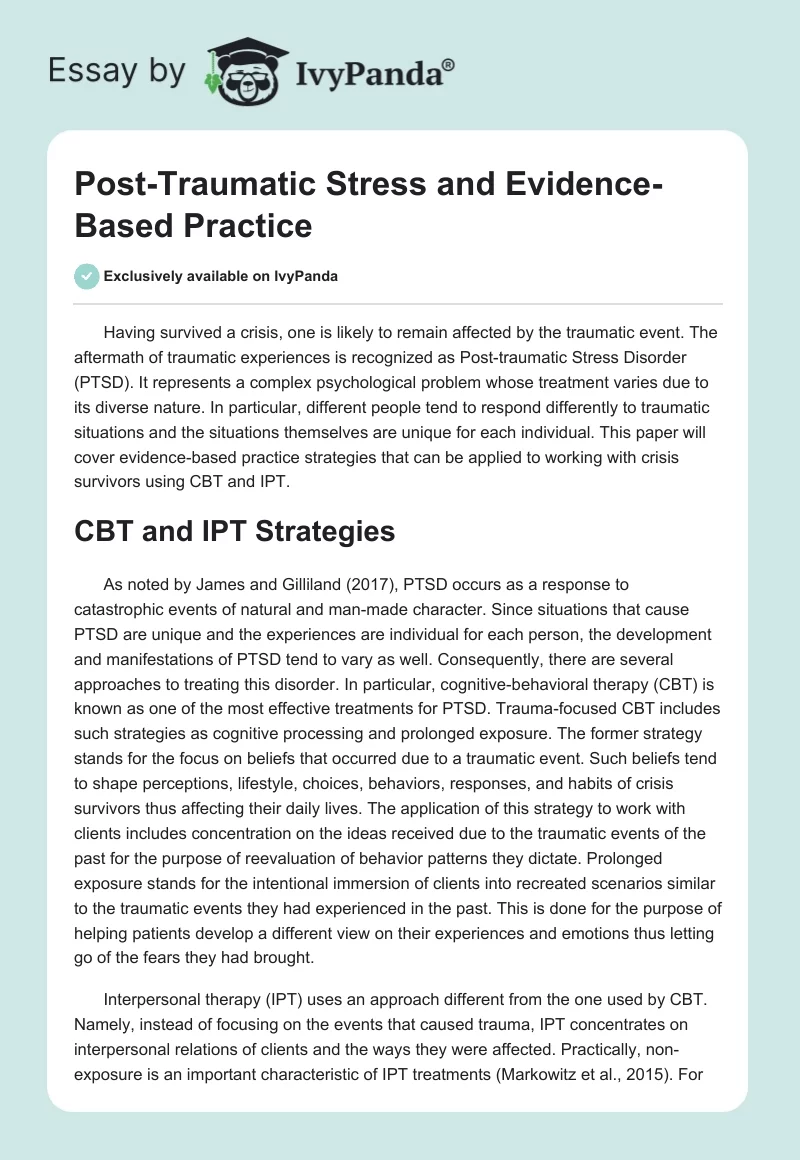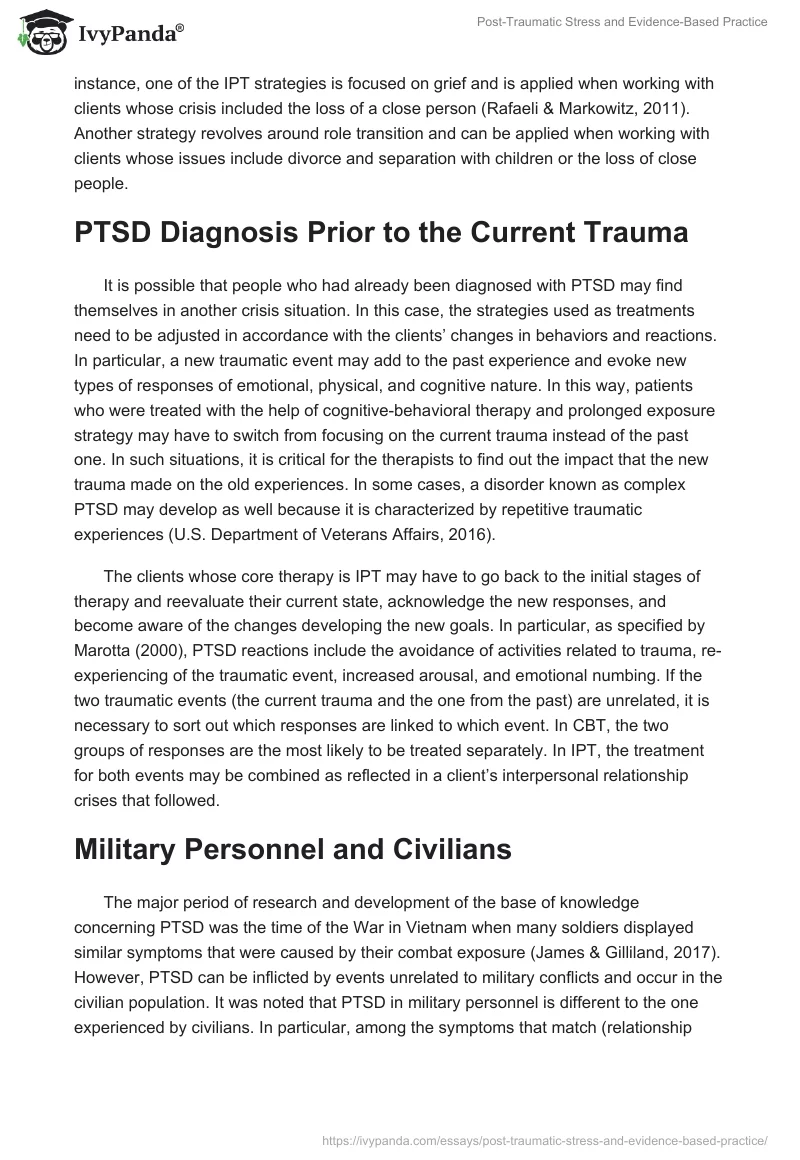Having survived a crisis, one is likely to remain affected by the traumatic event. The aftermath of traumatic experiences is recognized as Post-traumatic Stress Disorder (PTSD). It represents a complex psychological problem whose treatment varies due to its diverse nature. In particular, different people tend to respond differently to traumatic situations and the situations themselves are unique for each individual. This paper will cover evidence-based practice strategies that can be applied to working with crisis survivors using CBT and IPT.
CBT and IPT Strategies
As noted by James and Gilliland (2017), PTSD occurs as a response to catastrophic events of natural and man-made character. Since situations that cause PTSD are unique and the experiences are individual for each person, the development and manifestations of PTSD tend to vary as well. Consequently, there are several approaches to treating this disorder. In particular, cognitive-behavioral therapy (CBT) is known as one of the most effective treatments for PTSD. Trauma-focused CBT includes such strategies as cognitive processing and prolonged exposure. The former strategy stands for the focus on beliefs that occurred due to a traumatic event. Such beliefs tend to shape perceptions, lifestyle, choices, behaviors, responses, and habits of crisis survivors thus affecting their daily lives. The application of this strategy to work with clients includes concentration on the ideas received due to the traumatic events of the past for the purpose of reevaluation of behavior patterns they dictate. Prolonged exposure stands for the intentional immersion of clients into recreated scenarios similar to the traumatic events they had experienced in the past. This is done for the purpose of helping patients develop a different view on their experiences and emotions thus letting go of the fears they had brought.
Interpersonal therapy (IPT) uses an approach different from the one used by CBT. Namely, instead of focusing on the events that caused trauma, IPT concentrates on interpersonal relations of clients and the ways they were affected. Practically, non-exposure is an important characteristic of IPT treatments (Markowitz et al., 2015). For instance, one of the IPT strategies is focused on grief and is applied when working with clients whose crisis included the loss of a close person (Rafaeli & Markowitz, 2011). Another strategy revolves around role transition and can be applied when working with clients whose issues include divorce and separation with children or the loss of close people.
PTSD Diagnosis Prior to the Current Trauma
It is possible that people who had already been diagnosed with PTSD may find themselves in another crisis situation. In this case, the strategies used as treatments need to be adjusted in accordance with the clients’ changes in behaviors and reactions. In particular, a new traumatic event may add to the past experience and evoke new types of responses of emotional, physical, and cognitive nature. In this way, patients who were treated with the help of cognitive-behavioral therapy and prolonged exposure strategy may have to switch from focusing on the current trauma instead of the past one. In such situations, it is critical for the therapists to find out the impact that the new trauma made on the old experiences. In some cases, a disorder known as complex PTSD may develop as well because it is characterized by repetitive traumatic experiences (U.S. Department of Veterans Affairs, 2016).
The clients whose core therapy is IPT may have to go back to the initial stages of therapy and reevaluate their current state, acknowledge the new responses, and become aware of the changes developing the new goals. In particular, as specified by Marotta (2000), PTSD reactions include the avoidance of activities related to trauma, re-experiencing of the traumatic event, increased arousal, and emotional numbing. If the two traumatic events (the current trauma and the one from the past) are unrelated, it is necessary to sort out which responses are linked to which event. In CBT, the two groups of responses are the most likely to be treated separately. In IPT, the treatment for both events may be combined as reflected in a client’s interpersonal relationship crises that followed.
Military Personnel and Civilians
The major period of research and development of the base of knowledge concerning PTSD was the time of the War in Vietnam when many soldiers displayed similar symptoms that were caused by their combat exposure (James & Gilliland, 2017). However, PTSD can be inflicted by events unrelated to military conflicts and occur in the civilian population. It was noted that PTSD in military personnel is different to the one experienced by civilians. In particular, among the symptoms that match (relationship crises and distrust), there are also behaviors that are found specifically in soldiers – compulsive checking and desensitization to pain, loss, and death (Vincenzes, 2013).
The strategies applied to military personnel suffering from PTSD are to be similar to those aimed at the treatment of multiple trauma or complex PTSD. This is the case because combat exposure stands for repeated traumatic experiences as the soldiers continue to deploy and experience new traumatic events. Specifically, in order to diagnose PTSD in military and civilian clients, it is necessary to use two different forms that reflect the difference in experiences leading to PTSD in military personnel and civilians.
References
James, R. K. & Gilliland, B.E. (2017). Crisis intervention strategies (8th ed.). Boston, MA: Cengage Learning.
Markowitz, J. C., Petkova, E., Neria, Y., Van Meter, P. E., Zhao, Y., Hembree, E.,… Marshall, R. D. (2015). Is exposure necessary? A randomized clinical trial of interpersonal psychotherapy for PTSD. American Journal of Psychiatry, 172(5), 430-440.
Marotta, S. A. (2000). Best practices for counselors who treat posttraumatic stress disorder. Journal of Counseling & Development, 78, 492-495.
Rafaeli, A. K., & Markowitz, J. C. (2011). Interpersonal psychotherapy (IPT) for PTSD: A case study. American Journal of Psychotherapy, 65(3), 205-223.
U.S. Department of Veterans Affairs. (2016). Complex PTSD. Web.
Vincenzes, K. A. (2013). Comparison of civilian trauma and combat trauma. Web.


